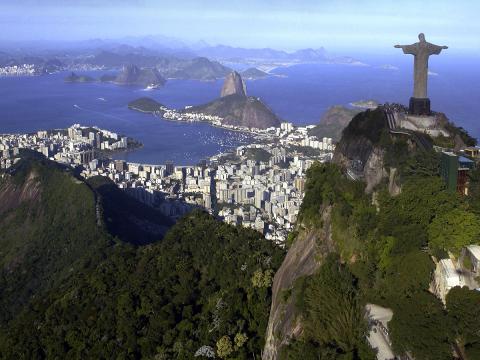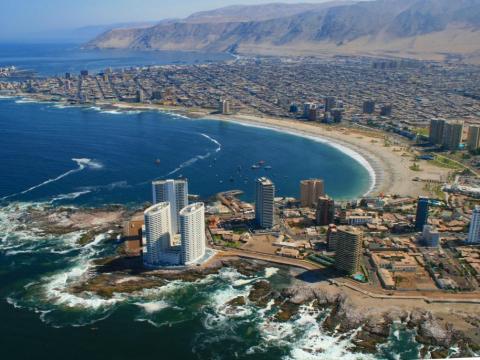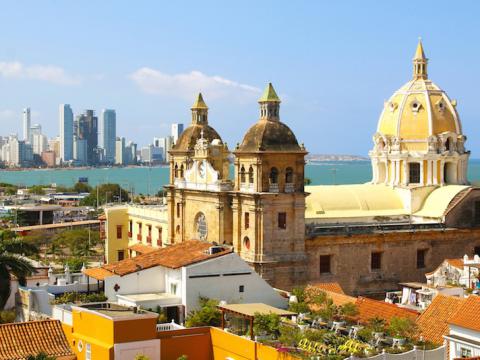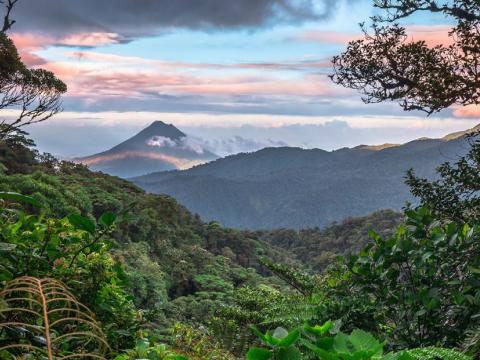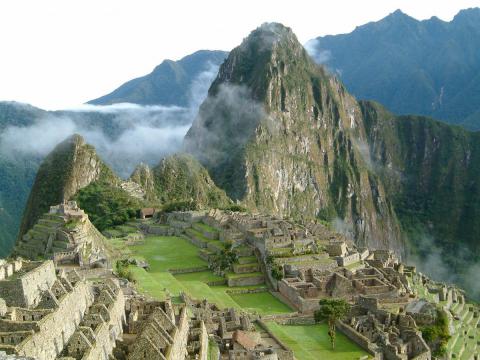Latin America in a Nutshell
Latin America plays host to some of the most amazing beaches, jungles, mountain ranges, forests, nature reserves, ruins, food, wine, and culture on the planet. From the mouth-watering, award-winning Argentinean steaks which rival the best from Australia (some might even say better than!), to the hidden valley reserves of the Brazilian vineyards, the food-and-wine-conscious traveler will find their palette well cared for while traveling through Latin America. Likewise the history buff or the outdoor enthusiast will find themselves in practical heaven due to the sheer amount of trails to be hiked, ruins to be explored, and things to uncover. The vast range of cultures leads to an interesting mix of people, foods, languages and more, and even the seasoned traveler will find themselves hard-pressed to keep amazement from entering their blood-stream.
The name “America” came from the Italian cartographer and explorer Amerigo Vespucci, who was the first European to demonstrate that Brazil and the West Indies were not the eastern side of Asia, but a different land mass entirely (that was in 1502). The term “America” is based on the Latin version of his name (Americus), and was eventually used to describe the entire New World on Garadus Mercator’s 1538 world map. Despite the controversy over the name for the previous decades (Spain believed the land should’ve been named after Christopher Columbus), America continues to be a prominent name and place in the world today.
Located in the western hemisphere, mostly in the southern hemisphere, with a small portion in the northern hemisphere. Equator runs through the north of the continent. South America may appear large, however it is the middle-sized continent on Earth—the 4th largest and 4th smallest! The entire continent spans 17.84 million square km of land. Brazil is the largest country in South America by land area, at 8,514,877 square km. 5.6% percent of the world’s population lives in South America. 209.5 million people live in Brazil, which is the 5th largest population of any country in the world. The largest city in Brazil is greater São Paulo, Brazil, where 27.6 million people live.
Central America is made up of seven different countries: Belize, Costa Rica, El Salvador, Guatemala, Honduras, Nicaragua, and Panama. Until the 1990s, people in this part of world were subjected to brutal and repressive rules, as well as proxy wars controlled or supported by either the United States or the Soviet Union. However, this region is currently in the process of reform that many hope will generate more stable and prosperous times. There are several interest colonial towns, like Antigua in Guatemala or Granada in Nicaragua, as well as ancient Mayan ruins in Belize, Honduras, Guatemala, and El Salvador. There are also beautiful beaches and good surf, particularly in Honduras, Nicaragua, Costa Rica and El Salvador. These countries also have beautiful national natural parks, like the rain forest (Rio San Juan) in Nicaragua. Guatemala is also well known for its volcanos on the southern shores of Lake Atitlan.
There are 12 official countries in South America, not including Caribbean island nations off the northeastern coast. They are Argentina, Chile, Brazil, Paraguay, Bolivia, Peru, Ecuador, Colombia, Venezuela, Guyana, Suriname, and Uruguay.
Brief history
Around 35 million years ago, the continent of South America detached from Antarctica to form the landmass we know today. Until more recently, the land was free of human life, and the biodiversity and climate evolved constantly, forming today’s magnificent biodiversity. While the history of human settlement in South America is still uncertain, there is evidence to suggest that humans emerged on the continent around the end of the last glacial maximum, which was 16,500-13,000 years ago. While the classic story about humans crossing the Bering Strait in North America and populated the entire Americas is widespread, there is evidence to show that many South American humans arrived from Africa via the coasts. Nonetheless, the first known human settlement is in the Norte Chico region of north-coastal Peru, also known as the Caral or Caral-Supe civilization. This settlement, Huaricanga, is dated at 3500 B.C.
Several societies of people emerged over these early years, including the sophisticated and widespread Inca Empire, which existed from the 13th to 16th century until the Spanish conquered their capital, Cusco. This empire spanned the entire Andes mountain range, including parts of modern day Peru, Ecuador, Colombia, Chile and Argentina. Once the Spanish took hold of modern-day Cusco around 1572, their expansion and eventual colonization of the continent commenced. This expansion included the enslavement and decimation of native peoples both by murder and disease, reducing their populations by estimates up to 95%. Indigenous groups remaining today, even some Incas, are ancestors of the surviving population.
The history of European colonization of South America is long, famous and gruesome. After the discovery of the New World in the 16th century, Spain and other European powers sent expeditions to explore and capture the new land. What first were small outposts of sailors and merchants turned into major European colonies that killed, tormented and ultimately enslaved the local indigenous groups. The first major colony of Spain was in Perú, from which many expeditions were led into the Amazon and Andes, and ultimately throughout the continent. Portugal colonized modern day Brazil, which is why its primary language is Portuguese today. The language spoken by most countries is Spanish, called Castellano in Argentina and Uruguay. However, the most widely spoken language is Portuguese, which is spoken in Brazil. The most common indigenous language still spoken is Quechua. Finally, English, Dutch, and French are spoken in Suriname, Guyana and French Guiana.
While South America has a long history of ethnic mixing and not-so-great relationships between groups, today there is wide assimilation of groups. However, ethnicity commonly has an impact on one’s social status and class—“white” people being of highest standing, “black” and “indigenous” the lowest. Postcolonial South America was a breeding ground for cultural (and ethnic) interchange. The African influences of freed slaves in northern Brazil contributed to forming new religions and festivities. Carnaval, one of the biggest festivals in the world, is heavily influenced by the Afro-Latino religion Candomblé and Roman Catholicism, which was forced on slaves and indigenous peoples by European settlers, remaining the primary religion on the continent. Carnaval originated in Brazil, but is celebrated all across Latin America.
In the same vein, due to colonization, some of the most preserved cultural sites are colonial cities, where architecture, museums and important historical monuments reside. The best colonial cities to visit are Cartagena, Colombia, Salvador, Brazil, Quito, Ecuador and Colonia de Sacramento, Uruguay. For a mixture of colonial and Incan influences, Cusco, Peru is a special cultural spot, as it was the capital of the Incan Empire before Spaniards made it their viceroyalty.
For a more modern but equally intriguing cultural experience, cities like Buenos Aires and Bogotá provide gorgeous architecture, world-class museums and art performances. The Gold Museum in Bogotá and MALBA, Museum of Latin American Art in Buenos Aires, have fascinating collections.
Living
In the recent years, emigration out of South America has decreased, and internal migration has increased. Typically, internal migrations tend toward the “Southern Cone:”Argentina, Chile and Brazil. These migrants are coming from Andean countries and Paraguay for the most part. With the most significant influences from indigenous and European cultures, South America is a massive melting pot of ethnicities. Mixed indigenous and Europeans, mestizos, are the most common in many countries (95% Paraguay, 72% Ecuador, 58% Colombia), while in many places these two ethnicities remain separate (Argentina 97% white, Uruguay 88% white, Chile 89% white, Peru 45% Amerindian). On the eastern, Caribbean side of the continent, there is much more African influence from the slavery days. Brazil, for example, is equal parts white as mulatto (black and white). In Colombia, Afro-Colombians outnumber Amerindians. In Guyana, there is a completely different demographic, consisting mainly of East Indian and Black ethnic groups. In Suriname, there is also a massive East Indian demographic, in addition to Creole groups.
In most countries in South America, and Latin America for that matter, there is a clear differentiation between ethnic groups based on opportunities and income. Major cities are melting pots of all kinds of people, the difference being that people of color living in deep poverty and white classes run the city (there are exceptions, of course, but this is unfortunately common). Argentina, Chile and Uruguay are dramatically majority 'white' countries, with little to no indigenous influence. This is the result of extermination of many indigenous groups by colonizers.
Another notable group in South America is the Jewish community in Buenos Aires and in the Argentinean farmlands. During WWII, Jews were invited to Argentina to populate farmland that a major philanthropist bought, giving them a new chance at life and him highly successful investment. As a result, contemporary Buenos Aires has the 3rd largest population of Jews outside of Israel and New York, USA.
Getting around
Public transportation is a major facet of society in every South American country, however it is not always timely or comfortable. For long distance transport, the most common and cheap way is bus. These buses range from luxury, business-class types to very tightly packed, uncomfortable types. Flying is also an option, but this requires a larger budget. Finally, taxis are very common in cities, though beware getting ripped off and ask a local how much your ride should cost before you go!
Given the variable terrain throughout, especially dense forests and mountains, the easiest and fastest way to travel around the continent is by airplane. However, due to the high cost of airline flights, especially for locals, transportation via bus and minivan is the most common way to get around, including long-distance travel. Taking a 24-hour bus ride in Argentina, for example, is not uncommon!
The major South American airlines that fly internationally are LATAM and Avianca, but many other airlines fly domestically and regionally. Azul Airlines, Aerolineas Argentinas, VivaColombia, TAME, Boliviana, Conviasa, and EcoJet are domestic airlines that fly regionally, and more cheaply. The honest truth, though, is that “budget airlines” don’t really exist in South America! So any of these flights will come at a cost. The true budget option is to move overland on a bus.
Trains are also very uncommon, again due to the variable terrain. There are, however, a few train routes that are generally used for touristic purposes. The Tren a las Nubes (Train to the Clouds) in northern Argentina has vast views of the Andes and Jujuy desert, while the Tren Crucero in Ecuador shows you volcanoes and jungle-clad countryside. For practical journeys, however, trains are not recommended. Stick to buses! They will have a bathroom on board for long distances and air conditioning with plane-like seating. Many of them are actually double-decker and of decent quality.
If riding on a bus, despite relative comfort, is not your cup of tea, then consider renting a car. The longest road in the world, the Pan-American Highway, runs along the west coast of the continent all the way down to the Arctic Circle! Other road systems, including some in the Amazon and the Andes, are possible routes. In the mountains, the zig-zag fashion of the roads in unbelievable! By road, you will be able to access most of the continent, but be aware that vehicles will most likely have a manual transmission, and 4-wheel-drive could be required to access roads, particularly during wet season.
Within major cities, there will be a public bus system, and the largest ones have a subway system (Buenos Aires, São Paolo, Caracas, Rio, etc.) Taking the subway is a very common mode of transport, especially for people going to work. If you are visiting areas that the subway systems do not reach, then a taxi is the next best form of transport (assuming no buses are available).
On the coasts and waterways, including within the Amazon, travel by boat or canoe is common. There are even places that can exclusively be reached via canoe!
For cruises, there are two main routes in South America: the Amazon route, and the Round-the-Horn route. The Amazon route is mostly in Brazil, stopping in many Amazon towns and nearby cities. The latter option, however, could be on many bucket lists, as it moves from Buenos Aires to Santiago, rounding the bottom horn of the continent and getting pretty close to Antarctica. If seeing the dramatic Patagonian landscape from the sea sounds awesome to you (it should!), this is the cruise to take.
Finally, in major cities, walking is a free, healthy and perfect way to explore.
Economy
The major industries in South America are agriculture, manufacturing, textiles and raw materials export. The main exports of the continent are coffee, sugar and tobacco, as well as many tropical fruits. The largest center for manufacturing is in São Paolo, Brazil, while Argentina and Chile also have notable levels of manufacturing. Textiles are widely made cross the continent, including traditional patterns made by indigenous groups. Finally, there are large oil and metal reserves throughout the continent, for example copper mines in Chile and oil reserves in Venezuela, that belong to the raw materials market.
Each country in South America has its own currency except for Ecuador, where the US Dollar is used. In some cases, especially along borders, bartering and trading of goods continues to flourish as a secondary market.
MERCOSUR is the largest trade bloc in South America, comprised of full members Argentina, Brazil, Paraguay, Uruguay and Venezuela. In light of the ongoing war, however, Venezuela has been suspended. Bolivia, Chile, Peru, Colombia, Ecuador and Suriname are associate countries, Bolivia being in the process to become a full member. This group supports free trade within member countries.
Tips
US Citizens, as well as many other citizenships, are allowed to enter any country in South America with a valid tourist visa for stays of 90-180 days. In some places, such as Brazil and Venezuela, you must obtain a visa prior to arrival to the country. These visas are valid for many years, but have a limit on the number of days you can be in the country per year. The majority of countries does not require a visa for tourism, or will give you a visa upon arrival if you pay a fee. Some countries, such as Peru, will allow you to enter for up to 180 days per year, not the common 90.
In South America, there are some places where you need to exercise more caution than others. If you are using public transportation in the city, your biggest danger is being pickpocketed or getting a bag stolen. For this reason, keep your bags in front of you at all times, with an arm covering it/them, even if the metro is packed with bodies.
When walking in the city, just be aware of your surroundings and use common sense. Most of the time, you and your belongings will be safe. Refrain from walking into dark alleyways or streets alone, especially in more rural areas, to avoid putting yourself in danger. If a local tells you to avoid a certain part of town, you should. If you can’t resist going anyway, do it during the day when there are many people around and it is light out. As a rule, never go at night.
When you travel by bus line, especially long distance, any large bags you have will be placed underneath or on top of the bus. With reputable bus companies, this is trustworthy, and you are given a receipt for any bags stowed away. If this bus stops along the way, however, you may want to exit the bus for a breather and quick stretch, watching what bags get unloaded from the bus at that stop, making sure yours is not one of them.
To get to know indigenous tradition and art, Peru, Ecuador and Bolivia are the meccas because of the existing indigenous communities today. Andean Indians are present throughout Peru, as in Ecuador. In Bolivia, where nearly everybody is at least half Amerindian, you will hear both Quechua and Aymara being spoken, Aymara communities predating the Incan empire (whose language was Quechua). Here, visit Tiwanaku, an archaeological site that showcases pre-Columbian instruments for irrigation, a sun gauge, and carved monolith art. For more traces of previous human societies, sites like Machu Picchu and the Nazca Lines in Peru are outstanding.
For anybody interested in theatre or opera, the Teatro Colón in Buenos Aires is a word class place to witness the arts. Made with luxury materials before the turn of the 20th century, this classy venue is spectacularly designed. It is known for having some of the best acoustics in the world, being the best room for Opera performances on Earth!
South America is perhaps one of the best places in the world for water sports. Most countries have a coastline, so there is plenty of opportunity to go surfing, sailing, paddle boarding and scuba diving. Due to the multitude of rivers on the continent, there are also white water rafting, canoeing, kayaking and fishing opportunities. Typically, American water sports like tubing and water skiing are less common.
When choosing a tourist resort, it will be best to decide on a country or region first, as there are hundreds of amazing resorts throughout the continent. What might be more important is to decide what kind of experience you seek, as there are resorts specializing in certain activities. From incredible eco lodges that will showcase nature to vineyard resorts that emphasize food, drink and leisure, there are endless options.
For winter sports specifically, it is easier to narrow down a place to go, as these will all be in Chile and Argentina. Nevados de Chillan, Corralco, and Portillo resorts in Chile are top picks for ski resorts in term of terrain variability, snow quality and space.
Last modified on 05/09/2021 - 21:31
Go Further!
Currently there are no places in Latin America.
Currently there are no trip reports about Latin America.
Currently there are no videos of Latin America.



